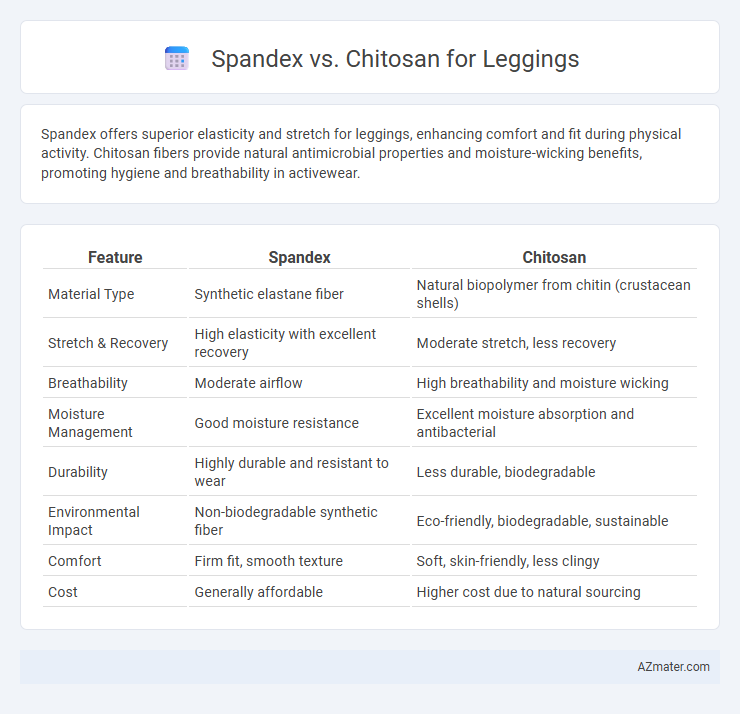Spandex offers superior elasticity and stretch for leggings, enhancing comfort and fit during physical activity. Chitosan fibers provide natural antimicrobial properties and moisture-wicking benefits, promoting hygiene and breathability in activewear.
Table of Comparison
| Feature | Spandex | Chitosan |
|---|---|---|
| Material Type | Synthetic elastane fiber | Natural biopolymer from chitin (crustacean shells) |
| Stretch & Recovery | High elasticity with excellent recovery | Moderate stretch, less recovery |
| Breathability | Moderate airflow | High breathability and moisture wicking |
| Moisture Management | Good moisture resistance | Excellent moisture absorption and antibacterial |
| Durability | Highly durable and resistant to wear | Less durable, biodegradable |
| Environmental Impact | Non-biodegradable synthetic fiber | Eco-friendly, biodegradable, sustainable |
| Comfort | Firm fit, smooth texture | Soft, skin-friendly, less clingy |
| Cost | Generally affordable | Higher cost due to natural sourcing |
Introduction to Spandex and Chitosan
Spandex, a synthetic fiber known for its exceptional elasticity, is widely used in leggings due to its ability to stretch up to 500% without losing shape, providing a snug and comfortable fit. Chitosan, derived from chitin found in crustacean shells, offers natural antibacterial and moisture-wicking properties, making it an innovative material for eco-friendly and hygienic leggings. Comparing these materials highlights spandex's durability and flexibility against chitosan's sustainable and functional benefits in activewear design.
Material Composition and Origin
Spandex, a synthetic fiber made from polyurethane, offers exceptional elasticity and is derived from petrochemical sources, making it lightweight and highly stretchable. Chitosan, a natural biopolymer extracted from the shells of crustaceans like shrimp and crabs, provides antimicrobial properties and biodegradability but lacks the inherent stretch of spandex. The combination of spandex's elasticity and chitosan's eco-friendly origin creates leggings that balance comfort, durability, and sustainability.
Comfort and Fit Comparison
Spandex provides exceptional stretch and recovery, ensuring leggings conform smoothly to body contours for maximum comfort during movement. Chitosan-infused fabrics enhance breathability and moisture-wicking properties, promoting dryness and reducing irritation in activewear leggings. Combining spandex's elasticity with chitosan's antimicrobial benefits results in leggings that offer an optimal balance of snug fit and all-day comfort.
Breathability and Moisture Management
Spandex leggings offer exceptional stretch and shape retention but often lack optimal breathability and moisture management, which can lead to discomfort during intense workouts. Chitosan-infused leggings enhance breathability by allowing better air circulation and effectively wick moisture away from the skin, promoting a dry and comfortable experience. Incorporating chitosan improves odor resistance and antimicrobial properties, making these leggings ideal for prolonged wear and high-sweat activities.
Stretchability and Shape Retention
Spandex offers exceptional stretchability with up to 500% elasticity, making it ideal for leggings that require high flexibility and comfort during movement. Chitosan, while naturally derived and antimicrobial, has limited stretchability and relies on blending with other fibers to improve shape retention and flexibility. Leggings made with spandex maintain their original shape longer, whereas chitosan-enhanced fabrics excel in moisture management and antibacterial properties but may compromise on elasticity and fit over time.
Antimicrobial and Odor-Resistant Properties
Chitosan fibers in leggings offer superior antimicrobial properties by inhibiting the growth of bacteria and fungi, which effectively reduces odor caused by perspiration. Unlike traditional spandex, chitosan-treated fabrics maintain odor resistance even after multiple washes, enhancing long-term freshness. This makes chitosan an ideal choice for activewear, providing durable hygiene benefits without compromising stretch and comfort.
Durability and Longevity
Spandex leggings offer exceptional elasticity and shape retention, ensuring durability through repeated stretching and washing cycles. Chitosan-infused leggings provide natural antimicrobial properties that reduce odor and fabric degradation, enhancing longevity. Combining spandex's flexibility with chitosan's protective benefits results in leggings that maintain structural integrity and hygiene over extended use.
Environmental Impact and Sustainability
Chitosan, derived from crustacean shells, offers a biodegradable and renewable alternative to petroleum-based Spandex, which significantly reduces microplastic pollution in legging production and disposal. Spandex relies heavily on non-renewable fossil fuels and emits greenhouse gases during manufacturing, contributing to environmental degradation. Leggings made with chitosan fibers promote sustainability by enhancing biodegradability and reducing reliance on synthetic, non-biodegradable materials.
Cost and Market Availability
Spandex leggings are widely available and cost-effective, with prices generally ranging from $10 to $50 depending on brand and quality, making them a popular choice in mass markets. Chitosan-infused leggings, leveraging the natural biopolymer derived from shellfish, are less common and typically more expensive, often priced above $50 due to specialized production processes and antimicrobial properties. Market availability for chitosan leggings remains limited, predominantly found in niche eco-friendly or high-performance athletic brands compared to the extensive distribution of spandex products.
Which Material is Better for Leggings?
Spandex offers superior stretch and elasticity, making it ideal for leggings that require flexibility and shape retention during physical activity. Chitosan, derived from natural sources, provides antimicrobial properties and enhanced moisture-wicking but lacks the same level of stretch as spandex. For leggings prioritizing performance and comfort, spandex remains the better choice, while chitosan is favored for its sustainability and hygiene benefits.

Infographic: Spandex vs Chitosan for Legging
 azmater.com
azmater.com